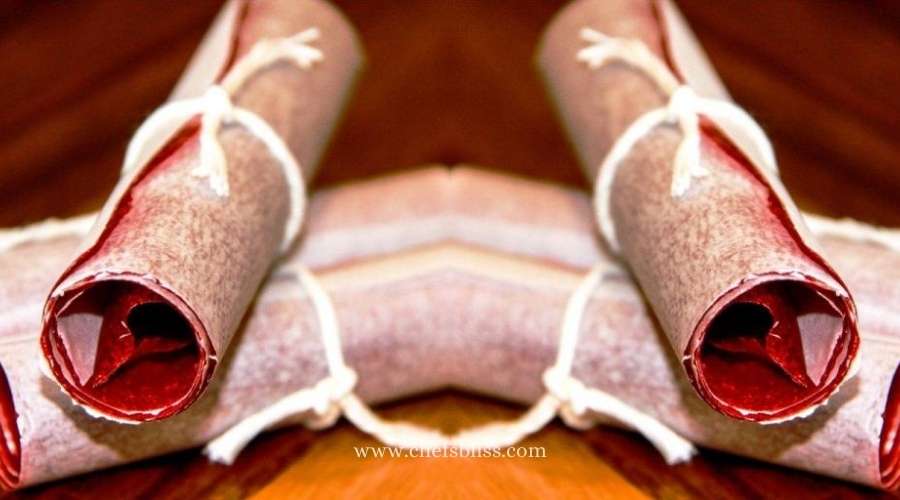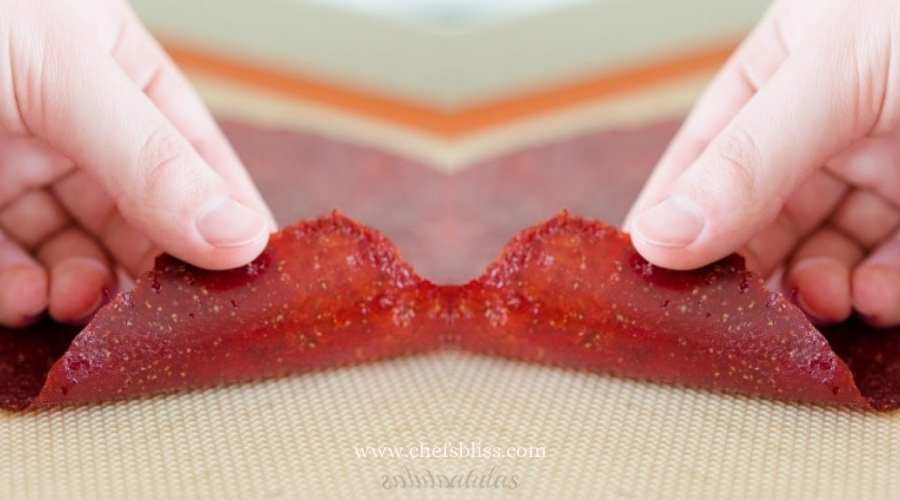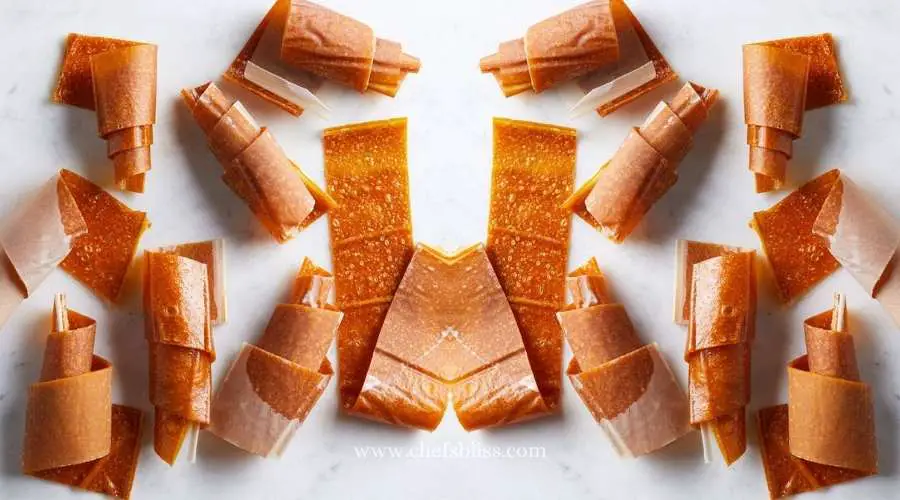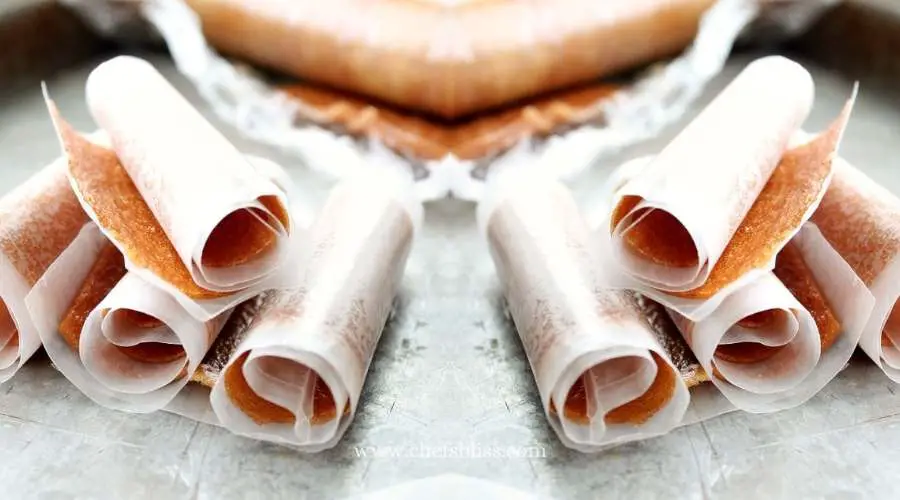Every product is independently reviewed and selected by our editors. If you buy something through our links, we may earn an affiliate commission at no extra cost to you.
Fruit leather, a delicious and nutritious snack, has gained immense popularity for its convenience and natural flavors. However, there’s one sticky issue that often plagues fruit leather enthusiasts: it can stick to parchment paper during the drying process. If you’ve ever faced this frustrating situation, fear not!
In this article, I will explore the reasons behind fruit leather sticking to parchment paper and provide you with practical solutions to ensure a smooth, non-stick experience.
Why is my fruit leather sticking to parchment paper?
Your fruit leather may stick to parchment paper due to factors like high sugar content in the mixture, improper parchment paper quality, inadequate preparation, or incorrect baking conditions.
The quality of the parchment paper you use also plays a significant role. Lower-quality parchment paper may lack an effective non-stick coating, leading to sticking problems.
Baking temperature and time are critical factors. Incorrect settings can affect how the fruit leather releases from the parchment paper.
Fruit leather sticking to parchment paper – What should I do now?
If your fruit leather is currently sticking to the parchment paper, here’s what you should do:

Cool It
Allow the fruit leather to cool completely on the parchment paper. This cooling process might make it easier to peel off later.
Check for Dry Edges
Sometimes, the edges of the fruit leather can be drier than the center. Gently lift the edges of the fruit leather to see if they release easily from the parchment paper. If they do, you can start peeling from the edges.
Use a Knife or Scissors
If the fruit leather is sticking stubbornly, use a knife or kitchen scissors to carefully cut around the edges of the fruit leather to loosen it from the parchment paper. Be cautious not to tear the fruit leather.
Roll It Up
If the fruit leather is still too sticky to peel off, you can try rolling it up while it’s still slightly warm. This can prevent further sticking as it cools.
After rolling, allow it to cool completely before unrolling and cutting it into desired portions.
Grease or Dust
For your next batch, make sure to properly prepare the parchment paper. Grease it lightly with a non-stick cooking spray or brush it with vegetable oil, or dust it with cornstarch or powdered sugar before spreading the fruit mixture.
Adjust Your Recipe
Consider adjusting your fruit leather recipe by reducing the sugar content or experimenting with different fruit combinations. This can help prevent sticking issues in the future.
Remember that practice makes perfect when making fruit leather, and even if it sticks this time, you can always try different techniques and adjustments for your next batch.
Also Read: How To Keep Potatoes From Sticking To Pan - A Comprehensive Guide
How to prevent fruit leather from sticking to parchment paper?
To prevent fruit leather from sticking to parchment paper, follow these steps:
Choose High-Quality Parchment Paper
Use good-quality parchment paper with an effective non-stick coating. Silicone-coated parchment paper or non-stick silicone baking mats are excellent choices.
Prepare the Parchment Paper
Before spreading your fruit mixture, cut the parchment paper to fit your tray or dehydrator racks. Grease the parchment paper lightly with a non-stick cooking spray or brush it with a thin layer of vegetable oil.
You can also dust it with cornstarch or powdered sugar for extra non-stick protection.

Optimize Your Fruit Mixture
Adjust your fruit leather recipe to reduce its sugar content. High sugar can cause sticking. You can also experiment with different fruit combinations to find the right consistency.
Baking Temperature and Time
Follow your recipe’s recommended baking temperature and duration. Avoid overbaking, which can lead to excessive drying and sticking. Underbaking can result in a sticky texture.
Cool and Dry Properly
After baking, allow the fruit leather to cool completely. Then, let it continue to air dry for a while to ensure it sets properly. This will help it release easily from the parchment paper.
Use a Knife or Kitchen Scissors
If you find that your fruit leather is still sticking slightly, use a knife or kitchen scissors to gently lift and release it from the parchment paper. Be careful not to tear the fruit leather.
Roll the Fruit Leather
Another technique to prevent sticking is to roll the fruit leather while it’s still slightly warm but not hot. This can help prevent it from adhering to the parchment paper as it cools.
Store Properly
To avoid sticking during storage, store your fruit leather in airtight containers with wax paper between layers. This prevents them from sticking together.
Also Read: Why Do My Russian Tea Cakes Fall Apart (Answered & Solution)
Is it necessary to use parchment paper for making fruit leather?
No, it’s not necessary to use parchment paper for making fruit leather, but it’s highly recommended.
Parchment paper serves as a convenient non-stick surface that makes it easier to remove the fruit leather after drying.
Without parchment paper, the fruit mixture might stick to the trays or dehydrator racks, making it challenging to peel off and potentially resulting in wasted fruit leather. Using parchment paper simplifies the process and helps ensure a smoother outcome.
Can I use wax paper instead of parchment paper for making fruit leather?
No, it’s not recommended to use wax paper instead of parchment paper for making fruit leather. Because wax paper has a wax coating that can melt and transfer onto the fruit leather during the drying process, affecting its taste and texture.
Parchment paper, on the other hand, is designed to withstand heat without melting or transferring any unwanted substances, making it a better choice for making fruit leather.
Also Read: How To Make Gummies That Don't Melt - Goodbye To Sticky
What type of parchment paper is best for preventing fruit leather from sticking?
The best type of parchment paper for preventing fruit leather from sticking is silicone-coated parchment paper. Silicone-coated parchment paper has an added layer of silicone, which enhances its non-stick properties and makes it ideal for various baking and drying applications, including fruit leather.
It provides a reliable non-stick surface, ensuring that your fruit leather easily releases from the paper without sticking or tearing.
Are there any alternatives to parchment paper for making fruit leather?
Yes, there are alternatives to parchment paper for making fruit leather. Some alternatives include:

Silicone Baking Mats
Silicone baking mats are reusable and offer excellent non-stick properties. They are a popular choice for making fruit leather and other baked goods. Just like silicone-coated parchment paper, they help prevent sticking.
Non-Stick Dehydrator Sheets
Some food dehydrators come with non-stick sheets designed for making fruit leather. These sheets are specifically made for dehydrating and are a convenient option.
Plastic Wrap
While not as commonly used, plastic wrap can be used as an alternative. Spread your fruit mixture on a plastic wrap-lined tray, dehydrate, and carefully peel it off when done. However, this method may require more attention to prevent tearing.
Silicone Food Dehydrator Trays
Certain food dehydrators offer silicone trays that are naturally non-stick. If your dehydrator includes these trays, they can be a suitable alternative to parchment paper.
Keep in mind that the effectiveness of these alternatives may vary, and it’s essential to follow proper preparation and drying procedures to prevent sticking and ensure a successful batch of fruit leather.
Is it possible to salvage fruit leather that has stuck to the parchment paper?
Yes, it is possible to salvage fruit leather that has stuck to the parchment paper. By allowing it to cool completely and gently lifting the edges, you can often peel it off.

However, there may be some parts where the fruit leather is damaged or less presentable due to sticking, but the salvageable portions can still be used.
How do I adjust my fruit leather recipe to avoid sticking issues?
To adjust your fruit leather recipe and prevent sticking issues, follow these steps:
Reduce Sugar Content: High sugar content can cause sticking. Decrease the amount of sugar in your fruit mixture. You can often use less sugar than the recipe suggests, especially if your fruits are naturally sweet.
Experiment with Fruit Combinations: Different fruits have varying levels of natural sugars and pectin, which affects the fruit leather’s texture. Experiment with different fruit combinations to find a balance that works for you. Adding fruits with lower moisture content can help.
Baking Temperature and Time: Follow your recipe’s recommended baking temperature and time. Overbaking can lead to excessive drying and sticking, while underbaking can result in a sticky texture. Adjust these parameters if needed based on your specific conditions.
Preparation of Parchment Paper: Ensure that you properly prepare the parchment paper by greasing it lightly with a non-stick cooking spray, brushing it with vegetable oil, or dusting it with cornstarch or powdered sugar. This provides an additional non-stick layer.
Cool and Dry Properly: After baking, allow the fruit leather to cool completely and continue to air dry for a while to ensure it sets properly. Proper cooling prevents sticking.
By making these adjustments to your fruit leather recipe, you can significantly reduce the chances of sticking issues and achieve a smoother, non-stick outcome.
Does the type of fruit I use affect whether it sticks to parchment paper?
Yes, the type of fruit you use can affect whether it sticks to parchment paper. Fruits with higher sugar content are more likely to stick because sugar becomes sticky when heated.
Additionally, fruits with higher moisture content can contribute to sticking because they take longer to dehydrate, increasing the chances of adhesion to the parchment paper.
Choosing fruits with lower sugar and moisture content can help reduce the likelihood of sticking and result in a better-textured fruit leather that releases more easily from the paper.
Conclusion
Making fruit leather is a delightful culinary adventure, and with the right knowledge and techniques, you can avoid the frustration of fruit leather sticking to parchment paper. By selecting quality parchment paper, preparing it correctly, adjusting your recipe, and following proper baking and drying procedures, you’ll be well on your way to enjoying perfectly non-stick fruit leather.
Don’t let sticking issues deter you—embrace the tips and tricks in this article and relish in the joy of creating your homemade, wholesome fruit snacks. Happy fruit leather-making!
References
- https://www.momables.com/how-to-make-fruit-leather/
- https://www.eatingwell.com/article/7959560/how-to-make-fruit-leather/
- https://chocolateboxcottage.tv/videos/fruit-leather-troubleshooting-guide/
- https://www.reddit.com/r/dehydrating/comments/j57m4l/how_do_you_get_your_fruit_leather_to_not_stick/
- https://homesteadingfamily.com/easy-fruit-leather-recipe/

